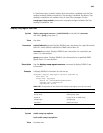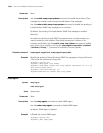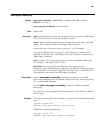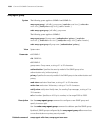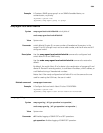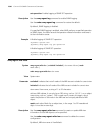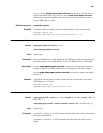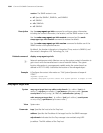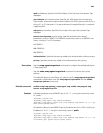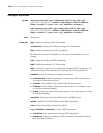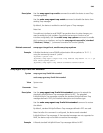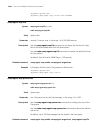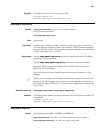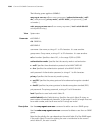2343
ipv6 ipv6-address: Specifies the IPv6 address of the Trap host that receives Trap
messages.
vpn-instance vpn-instance-name: Specifies the VPN where the host receiving
Traps resides, where vpn-instance-name indicates the VPN instance name and is a
string of 1 to 31 characters. It is case sensitive and is applicable only in a network
supporting IPv4.
udp-port port-number: Specifies the number of the port that receives Trap
messages.
params securityname security-string: Specifies authentication related
parameters, which is SNMPv1 or SNMPv2c community name or an SNMPv3 user
name, a string of 1 to 32 characters.
v1: SNMPv1.
v2c: SNMPv2c.
v3: SNMPv3.
authentication: Specifies the security model to be authentication without privacy.
privacy: Specifies the security model to be authentication with privacy.
Description Use the
snmp-agent target-host command to configure the related settings for
a Trap target host.
Use the
undo snmp-agent target-host command to remove the current
settings.
To enable the device to send Traps, you need to use the snmp-agent target-host
command in combination with the snmp-agent trap enable and the enable
snmp trap updown commands.
Related command: enable snmp trap updown, snmp-agent trap enable, snmp-agent trap
source, snmp-agent trap life.
Example # Enable the device to send SNMP Traps to 10.1.1.1, using the community name
of “public”.
<Sysname> system-view
[Sysname] snmp-agent trap enable standard
[Sysname] snmp-agent target-host trap address udp-domain 10.1.1.1 pa
rams securityname public
# Enable the device to send SNMP Traps to the device which is in VPN 1 and has an
IP address of 10.1.1.1, using the community name of public.
<Sysname> system-view
[Sysname] snmp-agent trap enable standard
[Sysname] snmp-agent target-host trap address udp-domain 10.1.1.1 vp
n-instance vpn1 params securityname public



